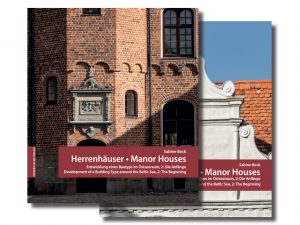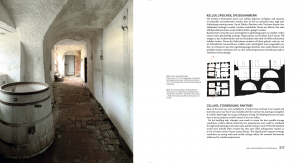Second volume on the bilingual typology of manor houses in the Baltic Sea region is published
 Sabine Bock: “Herrenhäuser. Entwicklung eines Bautyps im Ostseeraum • Manor houses. Development of a Building Type around the Baltic sea. 2: Die Anfänge • The Beginning”
Sabine Bock: “Herrenhäuser. Entwicklung eines Bautyps im Ostseeraum • Manor houses. Development of a Building Type around the Baltic sea. 2: Die Anfänge • The Beginning”
Photographed by Thomas Helms, translated into English by Sabine Bock and Angelika Halama • Thomas Helms Verlag Schwerin www.thv.de | thv@thv.de
2 volumes, 24,5 x 27,5 cm, 804 pages, hardcover, c. 1.000 illustrations, German/English, ISBN 978-3-944033-34-1
In the first volume of this typology the late medieval knights’ residences – Tower houses and Halls – were presented as a kind of ›prenatal‹ preliminary stage of the manor house in the Baltic Sea region. The early modern Fortified manor houses – are based on them. They are the end point in the development of castle building and the starting point for the development of the manor house. This real starting point is marked by a less defensible variant of the Fortified manor houses, which is to be called Early manor houses here. At the same time, an astonishingly large number of Stately half-timbered houses and houses in log construction were built. These three house forms represent the starting point for the development of stately homes on the manors. They are described in this second volume. While in the first volume only a comparatively small number of at least partially preserved objects and records could be used for the study, the starting point for this volume is much more convenient. In almost all regions of the Baltic Sea Region, Fortified manor houses and Early manor houses have been preserved, and even Stately half-timbered houses and houses in log construction could be proven in a comparatively large number and included in the considerations. And even Urban noble residences, which can hardly be found in the late Middle Ages, exist in representative representative numbers in all regions for the period of interest here and provide sufficient information for general considerations.
CONTENT || The Early modern period. New forms of Stately houses on the resulting manors | FOREWORD | HISTORY | The Baltic Sea Region and its history | INTRODUCTION | The agricultural system in the Baltic Sea Region in the Early modern period | Time and agriculture | The manors and the manor houses | Location of the manors | Farmyards | Subjects and their dwellings | Nobility, city and citizens | Nobility and church | Manor chapels | THE HOUSES | The Lords of the manor as builders | Leading buildings | Formal models | Master builders and craftsmen | Fortified manor houses | Distinction from the Early manor houses | Stately half-timbered houses | Stately houses in log construction | Urban noble residences | Gardens | BUILDING MATERIALS | EXTERIOR WORK | Foundations | Exterior walls | Half timbered construction | Windows | Roofs | Defensive elements | PORTALS, BUILDING INSCRIPTIONS AND SCULPTURES | Portals | Building inscriptions | Architectural sculpture | Terracottas | Symbols | INTERIOR WORK | Structural floors | Wooden beam ceilings | Vaults | Floors | Interior walls | Interior doors | Stairs | REPRESENTATIVE ROOM DECORATIONS | Stucco | Wall and ceiling painting on plaster | Textile wall decorations and wallpapers | Wooden ceilings, walls and panelling | Half-timbered colouring | ROOM PROGRAM AND FLOOR PLAN | MANORIAL ROOMS • FUNCTIONS AND FURNISHINGS | Dirnitzes | Dining rooms | Halls | Chambers of the squire | Women’s rooms | Nursery | Bedrooms | Guest rooms | SIDE AND UTILITY ROOMS | Floors, vestibules and corridors | Staff quarters and workplaces | Kitchens | Bakeries and breweries, food processing establishments | Cellars, storerooms, pantries | Bathrooms, washing facilities | Latrines | WARMTH AND WATER | Heaters | Chimneys | Fireplaces | Tiled stoves | Iron furnaces | Top Furnaces | Water supply | TRADITION AND PRESERVATION | Continuance | Rebuild and integration | Ruins | Total losses | Reconstruction | Catalogue of importent preserved buildings, which are treated exemplarily | APPENDIX
For further information regarding the book contact Prof. Dr. Sabine Bock, Schwerin sabine.bock@thv.de

